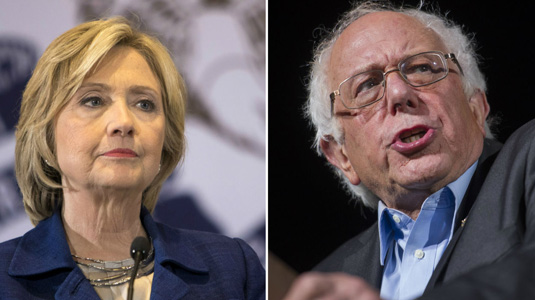
There is a wave of articles and comments, from Sanders supporters and from Clinton’s, trying to delineate their differences over a philosophy of change. Some liberal pundits damn Sanders with faint praise, saying that his philosophy of how change happens has never worked. And Sanders supporters lambaste Clinton for her Wall Street ties and for defending the incrementalism of the Obama administration on health care, financial reform, and the environment.
Some commentators see this as a fight over how to view President Obama’s accomplishments. They contrast the Sanders campaign, which focuses on reaching those still not covered by health insurance through expansion of Medicare, with Clinton’s campaign, which defends the results of Obamacare and seeks to improve on it.
The problem is characterizing the present moment as a world of either/or choices. Certainly primary voters and caucus-goers have to choose but one candidate. However, that is not the same as understanding the complexity of the real world.
We have to acknowledge, appreciate, and honor the massive changes brought about by Obamacare. Political efforts to expand health care coverage go back many decades, to Teddy Roosevelt at least. While Obamacare has limitations, mainly because it’s a kludge built on existing insurance and health care models, it has resulted in coverage for many millions of people – and that is worth celebrating. We can also, simultaneously, recognize the shortcomings built into Obamacare.
We need a system, new in some ways, that enables 100 percent health care coverage. Steps along that path are gradual improvements to Obamacare, a tangible accomplishment that needs defending from the rapacious Republicans who want to dismantle it and destroy some of the lives of those who rely on it.
Posing these two ways of accomplishing change ignores the ways they can, and must, support each other. If not for the reality of Obamacare, talking about improvements would be pointless. If we were still fighting about universal coverage, flailing about due to Republican obstruction with no success at achieving broader coverage, we’d be having a much different debate.
All this counter-posing is harmful in the long run. Whichever candidate is still standing at the end, s/he will have to win the other’s following. Much has been commented on from the perspective of “how will Clinton appeal to Sanders voters once she wins.” But the same is true in reverse: How will Sanders win over Clinton supporters, disappointed yet again that a woman hasn’t made it to the final race, discouraged by a Sanders approach that seems to reject the very idea of increments that can actually be won in our present political circumstances, not yet ready to reject all aspects of the Clinton legacy, angry that Sanders supporters (not Sanders himself) ascribe all Democratic opposition as selling out to moneyed interests. Sanders and Clinton both will have to win the other’s supportersin November.
It’s a built-in part of the process that each candidate needs to differentiate him or herself. But we don’t have to be drawn into destructive battles over the “perfect” approach to change, nor use arguments that resonate with Republican attacks. We don’t have to accuse Clinton of being a conscienceless sell-out hypocrite (though we shouldn’t ignore some of her history), nor Sanders as a wild-eyedradical idealist spouting unrealizable visions, as suggested by some of his rhetoric. Either will make a strong candidate against whichever troglodyte the Republicans nominate. Neither should we think that a Democratic victory will be easy: It will require unity among all the supporters of both candidates.
One cannot deny that there are serious limitations of both candidacies. Sanders bests Clinton on the use of force in foreign policy, but his international positions are far from perfect. Clinton edges out Sanders with her consistency fighting for gun regulation. Sanders is way more explicit about the necessity of building mass movements to force the political system to embrace actual fundamental change. Clinton, at the moment, appeals more to African American voters, a key constituency for victory in November.
All the kerfuffle about strategies of change ignores that it’s not about the personalities or the specific positions of the candidates; it’s about the movements that are built in the campaign. Arguably, Obama’s biggest failure as president is his abandonment of the independent movement that elected him, ceding power back to the Democratic establishment, thereby losing a powerful tool to pressure the political system for more basicchange. For example, if that independent movement had forced the adoption of the Employee Free Choice Act making union organizing more fair – which was endorsed by candidate Obama – the political landscape we face today would be much more favorable to progressive candidates and issues.
Change requires incremental improvements and smaller scale victories – and also a far-reaching, transformative vision. Posing these two against each other is not necessary. Without accepting that complexity, we are easily drawn into pointless battles over who is right and who is wrong, rather than how we together accomplish our mutual goals. Both philosophies of change can reinforce each other. Getting mired in arguments over whether or not Sanders is a “real” socialist, or who is most electable in some poll-dominated universe, does not help.
Whoever wins the Democratic nomination will have to build a movement capable of beating the Republican, whose victory – no matter the GOP nominee, as Noam Chomsky recently said – would be a danger to the survival of humanity.
For more on widening the focus beyond Sanders’ limitations to encompass the building of a movement for change, see this piece by Chauncey K. Robinson.
Photo: Scott Morgan and Cliff Owen | AP









